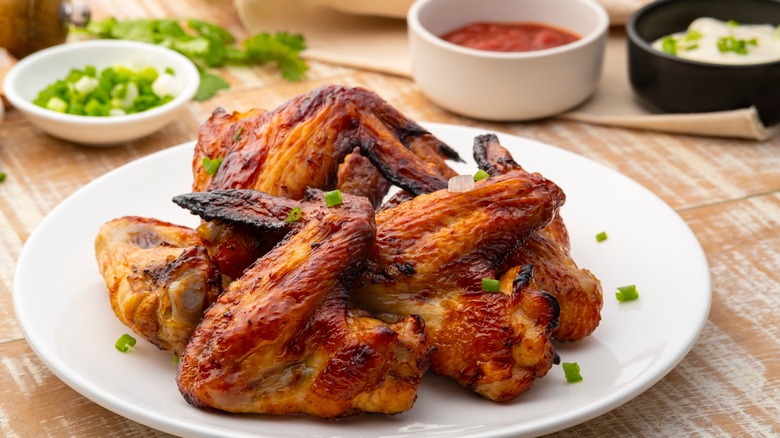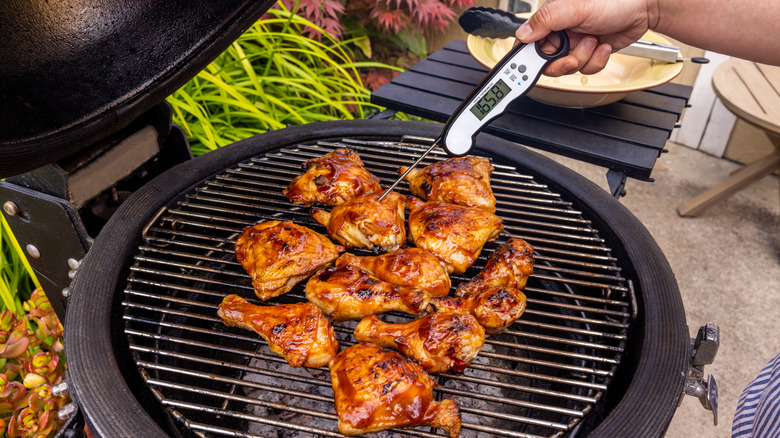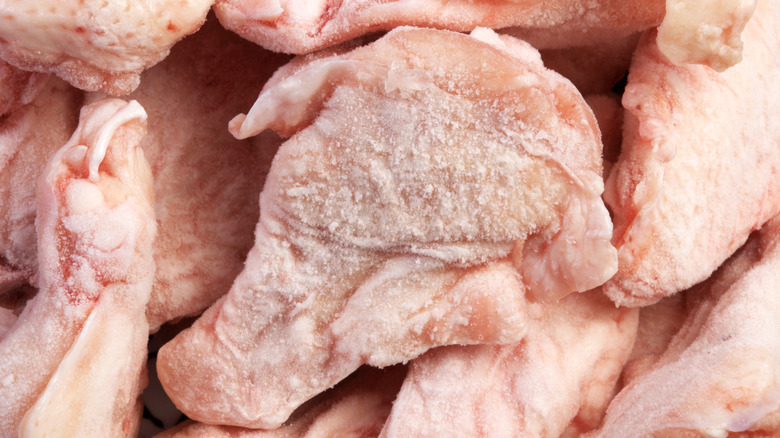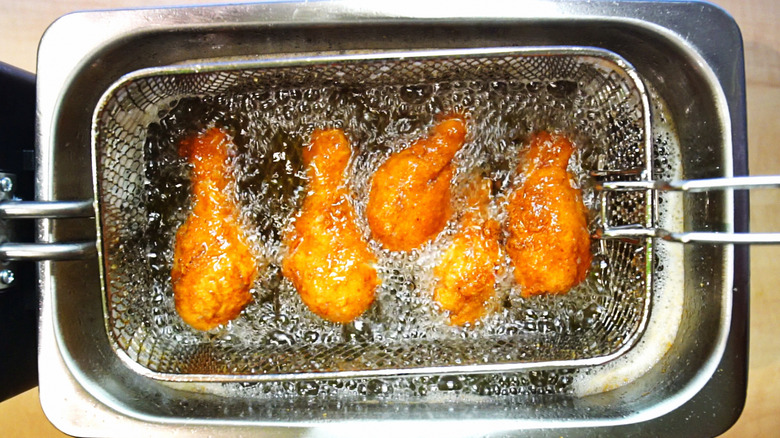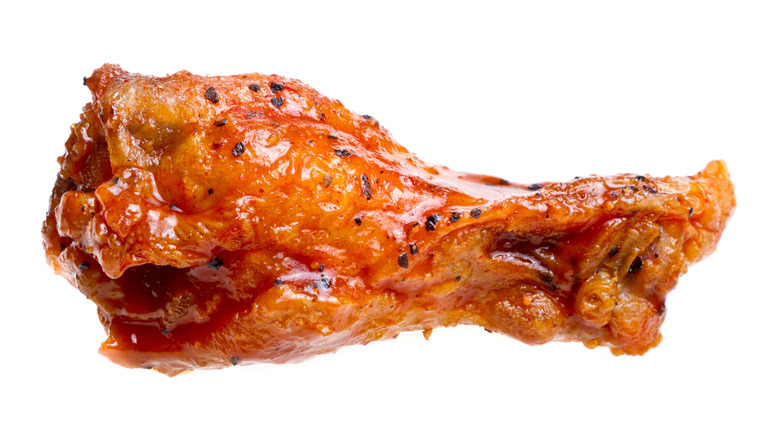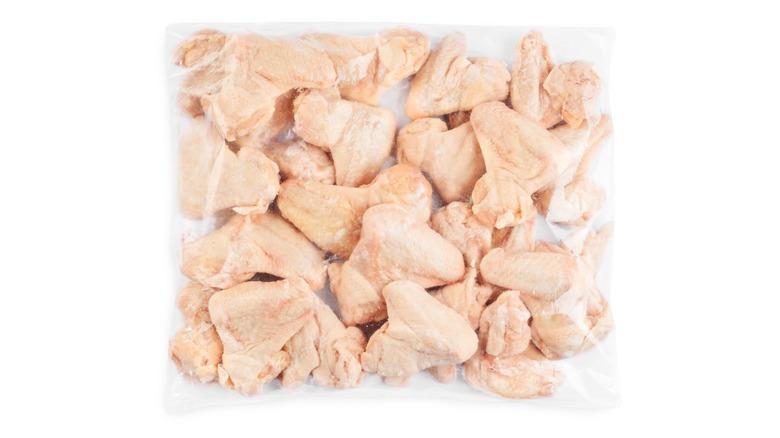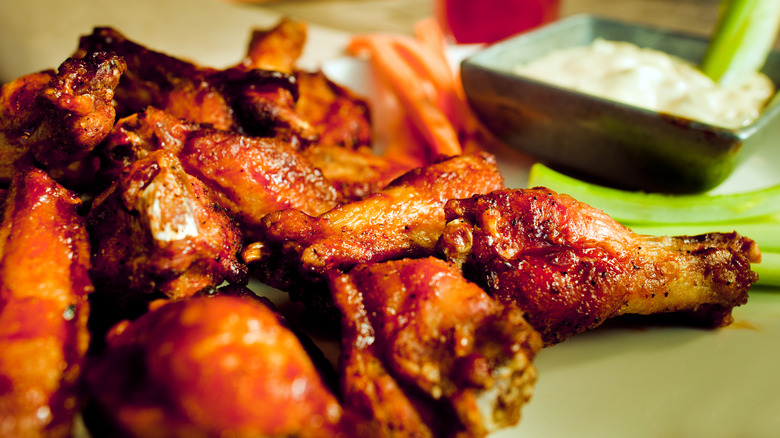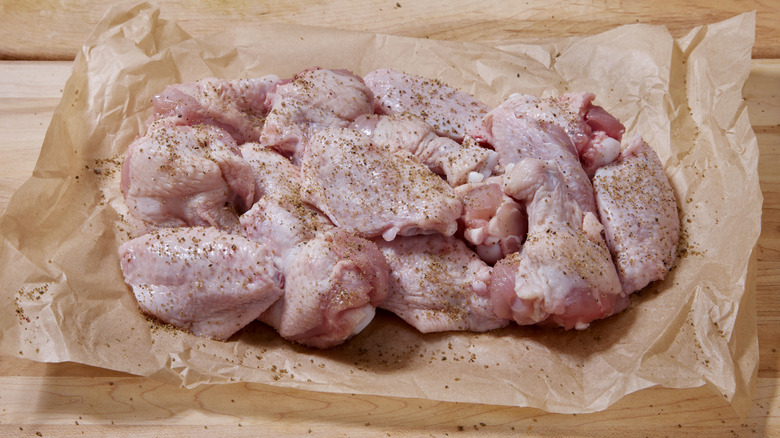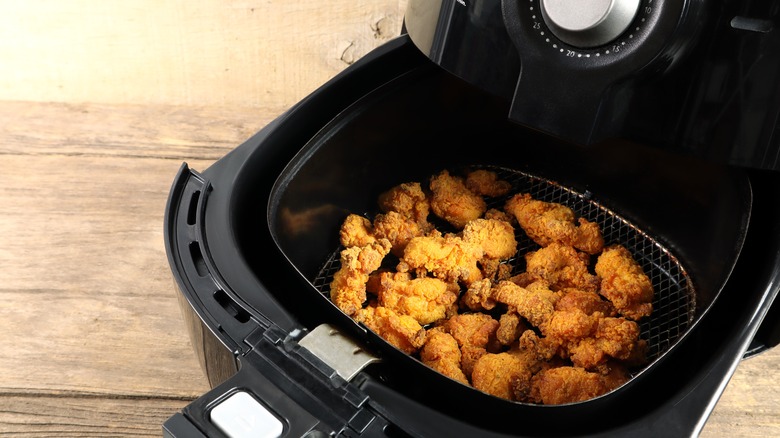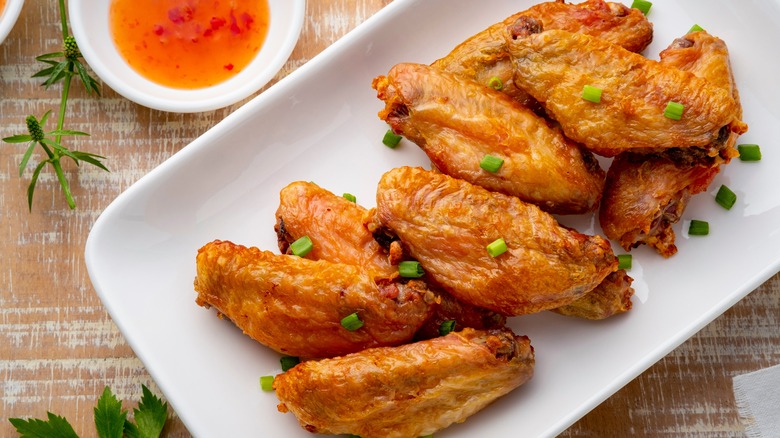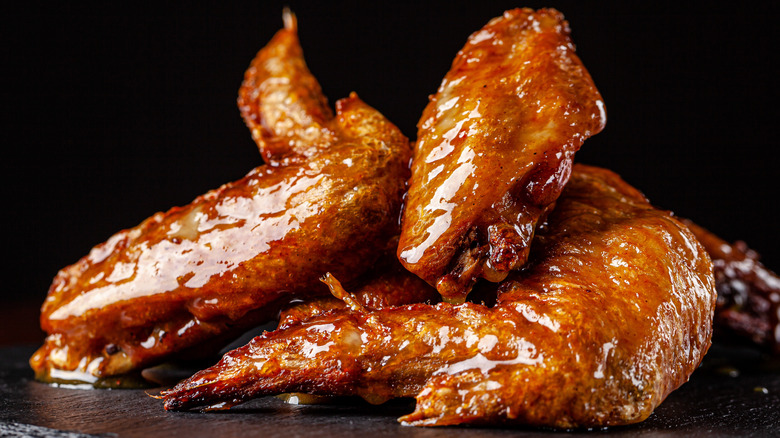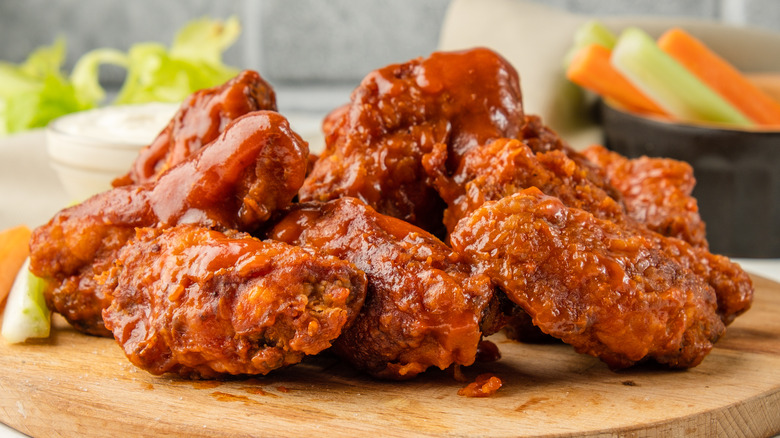Mistakes Everyone Makes When Cooking Frozen Chicken Wings
Cooking frozen chicken wings at home can be a convenient and satisfying way to enjoy a favorite appetizer or meal. However, despite the seemingly straightforward nature of this quick fix, there are some common pitfalls that many home cooks encounter when preparing this tasty dish. Whether it is under seasoning, undercooking, or overcooking, there's a myriad of mistakes that can happen when cooking wings from the comfort of your kitchen.
If there's one thing we know, it's that wings are worth even the smallest bit of extra effort during the cooking process, and once you taste the finished product you'll be glad you took some additional steps. So, let's dive into the most common errors that everyone seems to make when cooking frozen chicken wings, and more importantly, how to avoid them. Whether you're a novice in the kitchen or a seasoned chef, understanding these missteps will ensure your next batch of wings comes out crispy, flavorful, and downright delicious. Let's roll up our sleeves, preheat those appliances, and enjoy learning the secrets to perfecting frozen chicken wings every time.
Not using a meat thermometer
One of the most common mistakes when cooking any kind of poultry — including frozen chicken wings — is not using a meat thermometer. This device ensures the meat has reached the proper internal temperature and is safe to consume. Simply relying on visual cues can lead to undercooked or overcooked wings. Using a meat thermometer ensures that the wings are cooked to a safe internal temperature of 165 degrees Fahrenheit (74 degrees Celsius) at the thickest part. Doing so not only guarantees you can consume the wings safely but also that they will have an optimal taste.
While it might seem like you can eyeball whether your chicken wings are fully cooked, this method can be unreliable. The last thing you want is to give you or your guests food poisoning, so ensuring the chicken has reached the correct internal temperature confirms it is safe to eat and any harmful bacteria has been killed. Using a meat thermometer — which can be picked up relatively cheaply from places like Amazon – provides an accurate reading of the internal temperature, giving you peace of mind that your wings are cooked through without being undercooked or overdone.
Not defrosting before cooking
There is perhaps nothing worse than coming home to cook dinner after a long day and realizing that you didn't thaw the chicken you planned to make. For convenience's sake, we know it's tempting to cook frozen chicken in its icy state, but we're here to remind you that while it is possible to cook from frozen, you'll have better results if you defrost it first. Attempting to cook frozen chicken wings without defrosting them properly can result in uneven cooking and a less-than-ideal texture, such as being completely dried out.
If you want to avoid wings that are overcooked or undercooked, it is best to defrost them fully before cooking. This can be done by simply defrosting the wings at room temperature — you'll just need to ensure you plan ahead to give them enough time to thaw. To save time, you can put your frozen wings in the oven or air fryer while preheating. This can help thaw the frozen wings quicker and allow them to cook more evenly. The result will be tastier wings with better texture and an even cook, and it will ensure you prevent any potential food safety hazards by avoiding chicken that is still partly frozen.
Deep frying frozen wings
Another big mistake that home cooks can make, and one that can be extremely dangerous, is attempting to deep fry wings that are frozen. Any home cook should be aware that water and hot oil do not mix. One Reddit user confirmed this, saying, "Frozen foods into a fryer can potentially lead to disaster." However, further comments said it is doable if you have a deep fryer with a lid to contain the oil.
As frozen chicken wings are coated with frozen water, deep frying frozen chicken wings can result in the ice melting quickly in the hot oil, turning into steam, and creating large bursts and splatters of hot oil. This can cause injury to you and potentially cause a grease fire. Be sure to always prioritize your safety, and the safety of those around you, when cooking anything in the kitchen. It is best to thaw the wings fully before cooking by any method, but particularly so if deep frying them.
After they have been defrosted, patting the wings dry with some paper towels before frying removes excess moisture, preventing oil splatters and potential hazards. More than just making the wing frying process safer for you and your household, drying the wings before deep frying helps ensure they have a crispy exterior, which is an essential component of any great wing.
Relying on pre-seasoning on wings for all the flavor
In terms of making things simpler, buying pre-seasoned wings is, in theory, a convenient and quick way to achieve flavorful wings without having to do much extra work. However, although pre-seasoned frozen wings may seem like the easiest choice, they often lack the depth of flavor that comes from seasoning them yourself. For the best-tasting wings, we recommend adding your own blend of spices and seasoning after the frozen wings have thawed, as this allows you to customize the flavor exactly to your liking and ensures that enough seasoning is present.
If you did want to go the pre-seasoned route, try thawing the wings completely and adding more of your own spices to the outside. Adding additional spices to defrosted, pre-seasoned wings helps give extra flavor. A Reddit user also recommends adding corn starch alongside the extra seasonings to the outside of wings before cooking to ensure a good crunch. The result is a crispy, flavorful, juicy wing that will make your guests think you did all the hard work yourself.
Not breaking apart big frozen pieces
Another common oversight when cooking frozen chicken wings is failing to separate the wings and the flats that have been frozen together. Clumps of wings that are frozen together prevent heat from circulating evenly, leading to uneven cooking. As we know, undercooked wings are a surefire way to get a food-borne illness. Additionally, seasoning can't be evenly applied to the wings if they are stuck together, resulting in inconsistent flavor — some areas might be overly seasoned, while others will completely lack flavor.
That's why it's best to make sure the wings are separated before they are seasoned and especially before they hit the pan or oven. If they're frozen solid, thawing the meat even a little bit can make pulling them apart without damaging the skin easier. Once separated, thoroughly drying the wings ensures that the seasonings will adhere properly and ultimately help you achieve a crispy exterior during the cooking process.
Not cooking the wings twice
The best way to ensure your wings are thoroughly cooked and juicy on the inside and crispy on the outside is by adopting a two-phase cooking method. This technique involves an initial cooking phase meant to ensure the wings are cooked to a safe-to-consume temperature followed by a second phase aimed at crisping the exterior to perfection.
The first phase of cooking focuses on gently cooking the wings through to the center by cooking them low and slow, maintaining the moisture and tenderness of the meat. Using a food thermometer, check that the wings are perfectly cooked inside. Once the wings have come to the correct temperature, increase the oven or fryer temperature a bit. This allows the skin to crisp up beautifully, resulting in a deliciously crispy outer layer that contrasts perfectly with the tender, juicy meat inside. This dual cooking strategy guarantees that each wing offers the best of both worlds: a moist, flavorful interior and a crispy, golden-brown exterior.
Seasoning only at the start of the cooking process
How you season your frozen chicken wings is a crucial aspect of achieving the perfect balance of flavor and texture. A common mistake people make is applying seasoning only at the very start of the cooking process. This method, while seemingly straightforward, often leads to a disappointing outcome: the seasoning simply doesn't stick. When wings are seasoned too early, especially straight from the freezer, the spices and herbs end up mixing with the water as the ice melts, preventing them from adhering to the wings effectively. As a result, a lot of the seasoning is lost, leading to wings that are underwhelming in flavor.
A more effective approach is to introduce seasoning halfway through the cooking process. At this stage, the wings have partially cooked, shedding any initial layer of frost or ice. The surface of the chicken is dryer and warmer, creating an ideal setting for the seasoning to cling to the meat. This technique ensures that the seasoning clings to the wings, allowing for deeper flavor penetration and a more consistent seasoning coat across all pieces. This seasoning strategy not only enhances the flavor of the wings but also allows for a more even distribution, guaranteeing that each bite is packed with taste.
Using the same techniques regardless of appliance
Cooking frozen chicken wings to perfection involves more than just preheating your favorite kitchen appliance and popping them in. The truth is, the type of appliance you use — be it an oven, air fryer, or toaster oven — greatly influences the outcome of your wings, demanding adjustments in cooking times, temperatures, and techniques depending on which appliance you're using to achieve that ideal crispy exterior and juicy interior.
In an oven, for example, circulating hot air cooks the wings evenly, but achieving crispiness requires a higher temperature and possibly a longer cooking time compared to other methods. In an air fryer, rapid air technology cooks and crisps up wings with minimal oil. When air frying, you'll likely use shorter cooking time and slightly lower temperatures than an oven. That said, experts know that if you're using an oven-based recipe in an air fryer, you'll need to convert the cooking time and temperature accordingly.
Comparatively, toaster ovens have heating elements that will be in closer proximity to the wings themselves. This means that careful attention must be paid to cooking times and temperatures to prevent burning. Lower temperatures and periodic flipping might be necessary to ensure even cooking.
Experimentation is key across all appliances. Each has its benefits, and finding the right balance of time, temperature, and technique can lead to your ideal chicken wing experience.
Not adding oil to the wings before cooking
Incorporating a touch of oil to frozen chicken wings before cooking can significantly elevate their texture and taste. This simple yet effective technique is a game-changer in the kitchen, particularly when aiming for that coveted combination of crispy skin and juicy meat.
When oil is applied to the wings before they hit the heat, it creates a thin barrier around each piece, helping to evenly distribute the heat across the surface of the wings. As a result, the skin crisps up beautifully, providing that satisfying crunch with each bite. The oil also prevents the wings from drying out, ensuring that, despite the high heat needed to achieve crispiness, the inside remains moist and tender.
Oil also has a unique ability to carry flavors. By mixing oil with your choice of seasonings before applying it to the wings, you enhance the flavor of your wings. Oil helps to lock in the spices and herbs, ensuring they adhere to the wings and penetrate deeply as they cook. Whether you're a novice cook or a seasoned chef, this approach to preparing chicken wings can elevate the texture and flavor.
Not tossing the wings in sauce
There's no doubt that sauce is the star of the show when it comes to delicious chicken wings. Tossing cooked wings in a delectable sauce shouldn't just be an optional step but an essential one to unlock the full potential of this beloved dish. Neglecting to toss the wings in a sauce can lead to a disappointing dining experience characterized by uneven flavor distribution. Even if you usually prefer dry rubs, wing sauce can be helpful when you're using meat that's more susceptible to textural issues such as frozen wings. Saucing the wings not only enhances flavor but also contributes to their overall texture, adding a glossy sheen and extra moisture.
Tossing chicken wings in sauce can be done midway through the cooking process and at the end, ensuring that the flavor is baked in and coating the wing. So, the next time you cook up a batch of wings, don't skimp on the sauce — give them the treatment they deserve and prepare for tons of flavor in each bite.
Not letting them rest
Taking the time to let cooked chicken wings rest before serving may seem like a minor detail, but it can make a world of difference in the final taste and texture of the dish, resulting in wings that are not only juicier but also more flavorful. When chicken wings are cooked, the heat causes the juices to migrate towards the center of the meat. Allowing the wings to rest off the heat for a few minutes post-cooking gives these juices a chance to evenly redistribute throughout the meat. As a result, each bite becomes a burst of flavor, with the juices evenly distributed instead of escaping upon the first bite.
By allowing the wings to rest, you're essentially allowing them to retain their natural moisture and flavor, ensuring a more enjoyable eating experience for you and your guests. Additionally, the resting period allows the wings to cool slightly, making them safer and more comfortable to handle. It might be tempting to get stuck in straight away, but you'll have better wings if you're able to hold off just a little longer so they're at their very best.
